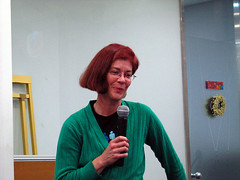Coincidentally, Mozilla had officially released Firefox3 in this period of time, so the Mozilla Korea Community hosted a Firefox Seoul party to celebrate the release of Firefox3. They also attended the party, so it made the event more exciting for the community.
Before the party, I had the opportunity to have dinner with Mitchell Baker and Gen Kanai. I heard about the story of how Mitchell started her career in IT and was involved in the Mozilla project. It was an awesome story. I think she is part of the history of the Web.
 I was also pleased to meet Gen, although we had not met each other, because I had seen his talk in the Lift conference and read his blog. So I felt like I was meeting people I was already acquainted with. In addition, he has already written about the Mozilla Korea Community activities and the unique situation of using ActiveX controls in Korea in his blog. So I'd like to thank him for his efforts.
I was also pleased to meet Gen, although we had not met each other, because I had seen his talk in the Lift conference and read his blog. So I felt like I was meeting people I was already acquainted with. In addition, he has already written about the Mozilla Korea Community activities and the unique situation of using ActiveX controls in Korea in his blog. So I'd like to thank him for his efforts.There were some events during the party. Firstly, we enjoyed an interesting video of introducing the new features of Firefox3 and some photos of the Mozilla Korea Community activities.

Secondly, we had a Q&A time with Michell Baker. She kindly gave us answers about many questions regarding Mozilla/Firefox despite the late time and busy schedule. It left me wondering where she got her power & passion.
As the chair of the Mozilla foundation, she has striven to make the people all over the world access the Web equally without any restrictions. So I think that those efforts make her more powerful and active.
Thanks, Mozilla for keeping the Web for everyone; I will also help Mozilla spread Firefox.
Photo by Gen Kanai
